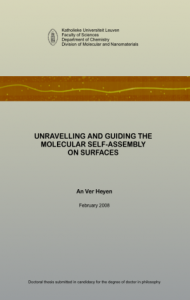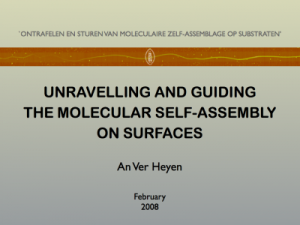My PhD
Thesis: Unravelling and guiding the molecular self-assembly on surfaces
- Contents (click here to view the table of contents)
- Full text (click here for the complete thesis, this can take some time)

- Presentation (click here to view the slides)
- Presentation (click here to see a movie, right click to `save as’)

Abstract:
Fabrication methods with a high level of molecular precision are required to keep up with the trend of minimising devices. Therefore, the need for novel techniques to make structures from molecular building blocks is rising. This work contributes in the unravelling and guiding of molecular self-assembly processes on surfaces. Self-assembly is a phenomenon which occurs spontaneously in the nanoscale world. The use of shape-persistent organic molecules with a well-defined shape, such as dendrimers and macrocycles, was investigated in this work. The goal is to implement molecular self-assembly in existing processes and techniques to create structures at the nanometre scale with a high level of precision. Parameters which define the outcome of the organic self-assembling systems on a surface were evaluated in order to gain insight in the self-assembly process. This knowledge could be employed in a later stage to guide the self-assembly process.
The outcome of the self-assembling of organic systems was studied with a variety of techniques such as light scattering (in solution) and mainly with scanning probe microscopy (on surfaces). Second generation polyphenylene dendrimers were used to construct nanofibres on a substrate and the impact of the substrate, concentration of the dendrimer solution, sample preparation conditions, solvent, and functional groups at the molecule’s periphery were studied. The `optimised method of sample preparation’ to obtain dendrimer nanofibres was found to be dropcasting a ~10(-5) M dendrimer solution in THF on piranha cleaned silicon in a THF saturated tank. The aggregation of another type of organic molecules, shape-persistent macrocycles, was studied to investigate the potential of these self-assembling molecules in construction methods to create nanostructures. These results reveal the importance of the intra- and extraannular substitution of the macrocycles in creating patterned surfaces and nanoscale objects.
A second aspect concerns the location and orientation of the prepared nanostructures on the substrate’s surface. The self-assembly process of the second generation polyphenylene dendrimers was implemented in a number of methods to manufacture structures in the nanoscale world. Soft-lithographic approaches were carried out by using stamps and molds to successfully direct the self-assembly process towards specific locations on the surface. In contrast to this method, the templating approach using binary patterns could not only direct the location of the aggregates on the surface, but additionally was able to control the shape of the aggregated structures. Nanofibres were aligned on the surface of a silicon substrate according to the templated substrate by applying the `optimised method of sample preparation’. Another method using a high magnetic field (up to 20 T) was employed to influence the self-assembly process of both a dendrimer and a macrocycle system. Only in case of the macrocycle, the magnetic field turned out to have an alignment effect, which is attributed to the proper (parallel) orientation of the phenyl groups in these self-assembled fibres, a situation which can not be reached in the dendrimer fibres.
The results of this study illustrate the potential and challenges of molecular self-assembly in combination with an orientation guided approach and open a path for further investigation of other systems in a combined top-down/bottom-up approach.